- Hotline: 852+ 2891 9689
- Whatsapp: 852+ 9146 8426
- [email protected]
- 6/F 29 Austin Road, Tsimshatsui, Kowloon, Hong Kong
Not everyone experiencing hair loss is automatically suited for a hair transplant. The ideal candidate is someone with permanent hair loss, such as the followings, and has a sufficient supply of healthy donor hair at the back or sides of the scalp.
Hair transplant is most effective when guided by proper diagnosis and long-term planning. That’s why a comprehensive medical evaluation is essential before committing to surgery.
A good candidate typically:
Hair transplantation involves removing permanent hair-bearing skin form the back and/or sides of the scalp ( donor area ). Then, using magnification, the tissue is dissected into follicular unit grafts ( containing 1-4 hairs each ). These small grafts are then meticulously planted into the bald or thinning area of the scalp ( recipient area ).
All hair transplant procedures, whether FUT, FUE, or ARTAS, include the following 3 steps. The main difference is just in step 2 the harvesting part
1 Local Anesthesia
2 Donor Harvesting
3 Graft Insertion
Unlike temporary solutions like wigs or topical treatments, a hair transplant offers a permanent, natural solution to hair loss.
Today, hair transplantation has transformed the way we manage hair loss. It not only restores a youthful appearance but also rebuilds confidence, helping people regain control over how they present themselves — personally, socially, and professionally.
For many, it’s more than just about hair — it’s about reclaiming their identity and quality of life.
Dr. Norman Orentreich, an American dermatologist, in his 1952 introduced the concept of “donor dominance,” laying the groundwork for contemporary hair restoration techniques. Its later publication in 1959 has contributed to the emergence of a multibillion-dollar global hair transplant industry, offering lasting solutions for receding hairlines and firmly establishing hair transplant as a significant aspect of American culture. The followings are the updated scientific principles:
Traditionally, scalp hair was classified into two categories: DHT-sensitive and DHT-insensitive. However, clinical experience suggests a more accurate classification involves three distinct types, each with different characteristics and responses to treatment:
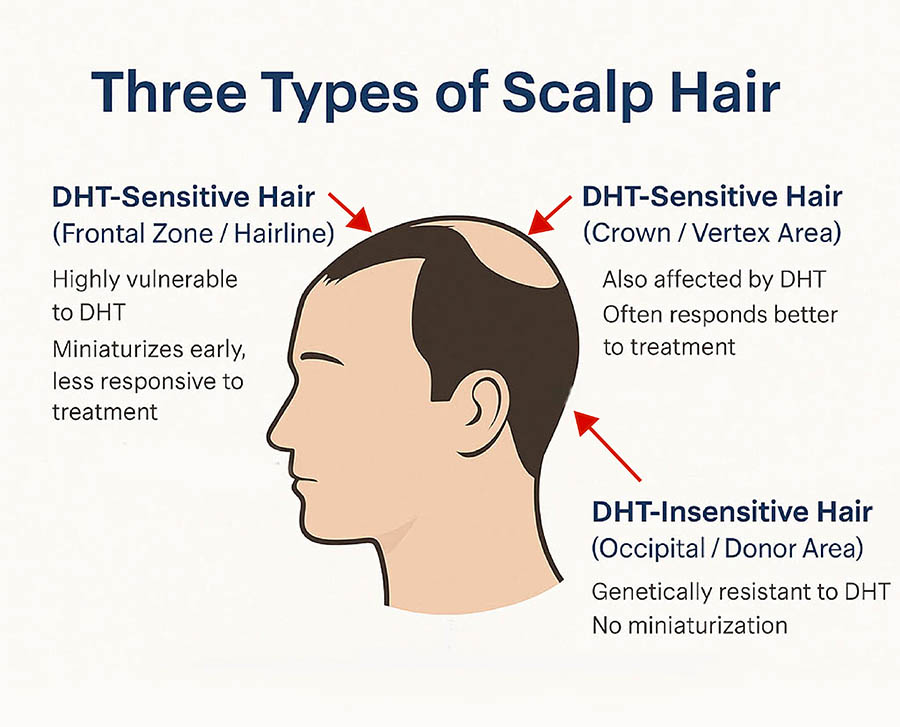
The cornerstone of modern hair transplantation has long been the Donor Dominance Theory. This principle holds that transplanted hair retains the characteristics of the donor site — such as color, curl, growth rate, and most importantly, resistance to DHT — even after relocation. This explains why there is no rejection, and why hair transplantation works so reliably.
However, advancements in the field have revealed a new layer to this understanding.
In the 2000s, Dr. Tommy Hwang (Korea) introduced the Recipient Dominance Theory. He observed that the recipient site can influence the behavior of the transplanted hair. For instance, scalp hair transplanted to the eyebrow tends to grow more slowly over time, gradually adopting the characteristics of the new location.
This breakthrough earned Dr. Hwang the ISHRS Gold Follicle Award, and reshaped how surgeons approach transplant planning — recognizing that both donor and recipient factors matter.

Regardless of the technique—FUT, FUE, or ARTAS robotic harvesting—every hair transplant procedure follows the same three core steps. The main difference lies in Step 2: how the donor hair is harvested.
Local Anesthesia
The scalp is numbed to ensure a pain-free experience during the procedure.
Donor Harvesting
Permanent hair is removed from the donor area, typically the back or sides of the scalp. Only good quality Grafts should be harvested for transplant to ensure good result.
Intact extracted grafts are sent to our assistants to trim all redundant tissues using 10X microscopic magnification.
The follicular unit grafts are then sorted into 1-hair FU, 2-hair FU, 3-hair FUs. The intact follicles are stored in chilled saline enriched with ATP to ensure maximal graft survival.
In FUT, a thin strip of scalp is excised and dissected.
In FUE, individual follicular units are extracted directly from the scalp.
In ARTAS, a robotic system performs automated follicle extraction.
Graft Insertion
Using high-powered magnification, harvested grafts—each containing 1 to 4 hairs—are carefully implanted into the thinning or bald areas. Each graft is placed at the correct angle, direction, and spacing to preserve existing follicles and ensure natural-looking results.Currently we are using 3 different Isertion Techniques depending on your hair characterd.
Forceps
Implanters
Stick & Place
Thanks to the use of tiny follicular unit grafts, today’s hair transplants produce soft, natural hairlines—a dramatic improvement over the unnatural “pluggy” results of older methods. At our clinic, we strategically combine single-hair grafts (for natural hairlines) and multi-hair grafts (for visual density) to achieve the most refined aesthetic outcome possible.
From historical breakthroughs to modern success — hair transplant is proven, permanent, and personal.
Hair transplant is not a trend. It’s a scientifically validated surgical procedure backed by over a century of global experience and continuous innovation. In this page, we explore how hair transplant works, why it succeeds, and what makes it a trusted solution for millions—including celebrities, professionals, and even doctors themselves.
Hair loss caused by male pattern baldness (Androgenetic Alopecia) is linked to DHT (dihydrotestosterone), a hormone that shrinks hair follicles over time. However, not all scalp hairs respond to DHT. DHT-resistant follicles, typically located at the back and sides of the head, are genetically programmed to last a lifetime.
Hair transplant works by relocating these permanent hairs to thinning or bald areas. Thanks to the principle of Donor Dominance, discovered by Dr. Norman Orentreich in 1959, we know that transplanted follicles retain their original characteristics—including resistance to DHT — no matter where they are placed. This means:
Doctors and scientists agree on the biological foundation of hair transplant:
This is how you preserve your grafts, your appearance, and your confidence — for years to come.
Hair transplant is not a new idea. Dr. Norman Orentreich, an American physician, performed the first hair transplantation for male pattern baldness in 1952. Here’s a brief historical timeline:
| Year | Breakthrough |
|---|---|
| 1882 | Dr. Joann Dieffenbach (Germany) initiates auto-hair transplant using goose-quill tools |
| 1939 | Dr. Shoji Okuda (Japan) performs punch grafting—30 successful cases published |
| 1952 | Dr. Orentreich (USA) performed the first hair transplant for hair loss in men. |
| 1959 | Dr. Orentreich published his "Donor Dominance" laying the foundation of modern transplant |
| 1990 | Dr. Inaba (Japan) pioneers early Follicular Unit Extraction (FUE) |
| 1991 | Dr. Bobby Limmer (USA) introduces microscopes for precise graft dissection |
| 2005 | Dr. Jerry Wong (Canada) develops Ultra-Refined FUT (UR-FUT), raising density and naturalness |
In 2016 alone, over 635,000 hair transplant procedures were performed worldwide—an increase of 280% from 2006. The total market exceeded HK$47 billion, with Asia performing more than 200,000 procedures, second only to the U.S.
Men made up 86% of all cases, mostly between ages 20 to 59, proving that hair restoration is both medically valid and socially accepted.
Public figures worldwide have openly embraced hair transplant surgery:
Their openness has helped reduce stigma and highlight the natural results achievable through modern techniques.
It’s not uncommon for doctors who suffer hair loss to get a transplant—and become so impressed by the results that they train in the specialty. This is a testament to how credible, effective, and transformative hair transplant can be when done right.
1. Before-and-After Galleries
Thousands of clinics worldwide display real patient transformations—offering visual proof of transplant success.
2. Medical Publications
Hair transplant is well documented in peer-reviewed journals, textbooks, and scientific conferences dating back to the 1930s.
3. Tax Recognition by Governments
In countries like Canada, hair transplant was previously eligible for income tax deduction as a medical procedure.
4. Endorsement by Medical Institutions
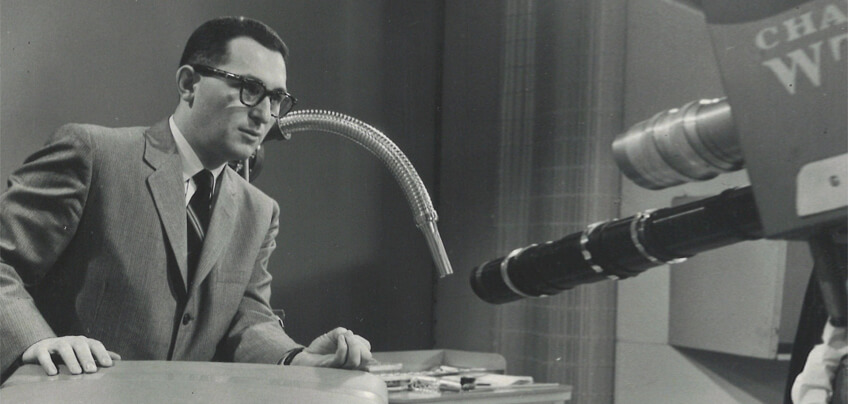
In 1939, the first published methods for hair transplant (also called grafting) was achieved by a Japanese Dermatologist, Dr. Okuda. Unfortunately, much of the hair transplant history was not credited to him since World War II crumbled the Western Hemisphere.
The actual process of the remedy for a balding head surfaced in 1952 in New York City. Dr. Normal Orentreich submitted the first proposal for a hair transplant operation. His first few drafts about hair transplant were actually rejected by the medical community. However, during the latter months of 1952, he performed the first hair transplant for male baldness. This operation worked under the principle that transplanted hair will continue to grow normally and will even exhibit the same characteristics it had where it originally grew. Here we would examine how hair transplant evolutes over the last 75 years.
J. Dieffenbach of Wurzburg, Germany had written thesis about concept of autotransplantation of hair, feather, and skin in animals and fowl. Success with the use of goose quills as trephines.
Okuda had written a paper in Japanese Journal of Dermatology on punch grafting of hair for alopecia on the scalp, eyebrow, moustache and pubic areas.
The world first hair transplant surgery for Androgenetic Alopecia was performed by Dr. Norman Orentreich in 1952. he relocated balding resistant hair follicles (10 4mm grafts) from the back and sides of the head to the balding scalp for MPB. His first paper appeared in NewYork Academy of Sciences in 1959. He established the first medical hair clinic in USA. Director of the Orentriech Foundation for the Advance of Science. This early procedure involved punching out a round piece of hair-bearing tissue 4-mm in diameter directly from the back of the scalp. Such graft contained about 20 hair and produced a rather pluggy appearance. This punch graft technique remained the standard for 20 years.

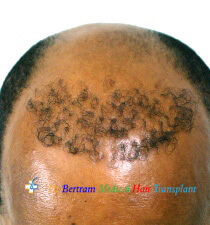
With this hair transplantation concept, physicians began to perform hair transplants for cosmetic improvement. And like most new developments, the first attempts were less than perfect. Doctors were successful in transplanting hair from the sides and back of the head to the top, but the results looked unnatural and obvious. These older and obsolete methods of hair transplantation practiced in the 1960’s and 1970’s nearly always resulted in a “clumped” or “bristle brush” appearance. The “Barbie Doll” appearance of hair transplant plugs (round grafts containing generally 15-25 or more hairs) is unfortunately nearly always quite conspicuous, and worse, permanent.
1967 Richard Shiell pioneered Hair Transplantation in Australia
These were introduced by Sam Ayres III using 1.5 to 2.0mm punch. He also described the term “follicular units”. He omitted pressure bandage in his patients.
1992 Patrick Frechey described Scalp Extension.
Surgeons began to combine both mini- and micro-grafts in their procedures. The small micro-grafts were use to soften the frontal hairline, while the larger mini-grafts were placed in the center of the scalp to create a high density appearance. Mixed grafting slowly replaced the plug technique and became the new standard in the 1990’s. However the result is still not natural on close inspection.
In 1994 Dr. Bobby Limmer (USA) first described the technique for isolating follicular units (FUs) using a microscope. This process enables the removal of redundant tissue. The grafts were kept as small as possible while preserving the integrity and all growth elements. Transplanting exclusively FUs produced far superior results.
Since 2000 Follicular Unit Transplant (FUT) has become the gold standard of surgical hair restoration.
In the mid-1990s, Dr Rassman (USA) set out to extract Follicular Units using a small punch. The same approach was described by Dr Inaba (Japan) in his 1996 textbook. The problem remained to be solved was the high transection rate. Rassman addressed that only 60% of all patients were good FUE candidates.

1973 O’Tar Norwood introduced the classification of MPB, co-founder with Dow Stough of the International Society of Hair Restoration Surgery, and later founded the Hair Transplant Forum International (1990-1995).
Marcelo Gandelman pioneered the use of motorized punch transplantation. Basically automatic FUE started in the 70’s.
Obviously these procedures required dramatic improvements. Over the course of years the technique of hair transplantation evolved. During the 1980s, minigrafts ( smaller clumps containing 5-8 hairs ) were an improvement, but only served to generate smaller “plugs”. Indeed, many hair restoration procedures involve the repair and/or hairline camouflage of these “plugs” or “minigrafts”. Even more unfortunately, some hair transplant doctors still utilize these larger grafts.
As techniques have improved, the grafts have become smaller and the number transplanted per session has increased. Today most hair transplant surgeons use grafts that have from one to eight hairs, with 200 to 800 grafts transplanted in each session. Although this is a major improvement over the larger grafts, this procedure still can produce a slightly unnatural look.
1981 The micrograft hair transplant procedure represented a bold achievement in the field of hair restoration. It was first used to create a subtler and more natural end result. Prior to the development of the micrograft procedure, hair transplant surgeons would extract large sections of hair from the donor area that would leave large scars and produce obvious signs that a transplant had been performed.
1982 Pierre Bouhanna developed the Photorichogram.
In 1984 a strip of tissue was excised from the donor area and then dissected into smaller grafts containing about 6 hair mini graft. Later the size of the grafts was further reduced to contain just 1-2 hair micro-graft
1988 Robert Limmer carried out the first pure follicular unit transplant. This opened the new era in surgical hair restoration techniques. With this follicle-unit micrografting, many hundreds or thousands of tiny, living grafts containing only one, two, three or four hairs are inserted in closely spaced fashion over the entirety of the bald and thinning areas. These follicle-unit micrografts, which approximate the one to four hairs which naturally originate from each of your original follicles, result in a very natural, aesthetic appearance. Randomly-spaced single hair micrografts are used in the very front of the hairline to create an especially pleasing, feathered hairline.
1992 Patrick Frechey described Scalp Extension.
Surgeons began to combine both mini- and micro-grafts in their procedures. The small micro-grafts were use to soften the frontal hairline, while the larger mini-grafts were placed in the center of the scalp to create a high density appearance. Mixed grafting slowly replaced the plug technique and became the new standard in the 1990’s. However the result is still not natural on close inspection.
In 1994 Dr. Bobby Limmer (USA) first described the technique for isolating follicular units (FUs) using a microscope. This process enables the removal of redundant tissue. The grafts were kept as small as possible while preserving the integrity and all growth elements. Transplanting exclusively FUs produced far superior results.
Since 2000 Follicular Unit Transplant (FUT) has become the gold standard of surgical hair restoration.
In the mid-1990s, Dr Rassman (USA) set out to extract Follicular Units using a small punch. The same approach was described by Dr Inaba (Japan) in his 1996 textbook. The problem remained to be solved was the high transection rate. Rassman addressed that only 60% of all patients were good FUE candidates.
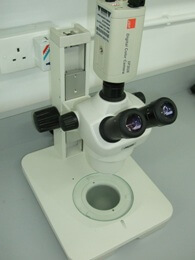
The main drawback of strip is a linear donor scar. The Trichophytic Closing Technique was introduced by Dr Marzola (Australia) and Dr Frechet (France) in 2005 to minimize the donor scar. This allows hair to grow through the scar as camouflage so that in most cases the scar is minimal if not invisible.

To speed up the extraction automatic devices were introduced. This included the Neograft, Dr Harris S.A.F.E. System, and Dr Cole C.I.T. System. All involved a motorized punch, sharp or dull.
Dr Jerry Wong of Canada pioneered dense packing and megasession, the hallmarks of Ultra-Refined FUT. From 2005 to 2010 the number of graft has increased from 3,000 (megasession) to over 5,000 (gigasession). In just one session a large area can be covered by a high density (of grafts (40-60 FUs/sq.cm).

Adopting the concept of Dr Shiao (Taiwan), Dr Bertram Ng (Hong Kong) invented the first hand-held laser in hairline placement. The device was later used by Physicians all over the world.
The Robotic system was first introduced in USA, when FUE harvesting was partially performed by a remotely controlled mechanical arm. Since 2012 the machine was sold to Physicians all over the world.
This technique was developed by Dr Bertram Ng in 2013 to increase graft survival by combining different FUT techniques. FUT-X differs from the Mega- or Giga-session approach in using the minimal number of grafts to achieve the best comestic result. This technique was later replaced by Mixed Graft Transplant.
A new approach in hairline restoration for female was first described by Dr Bertram Ng in the 2013 ISHRS Annual Scientific Meetings. He emphasized that the new hairline is simply an extension of the flows of existing hair.
Hair transplant procedures generally take from 6-8 hours and are performed using local or twilight anesthesia on an out-patient basis. Patients are often awake but feel relaxed as they are given a mild sedative.
There is usually little or no pain during the surgical procedure. Nowadays no bandage is necessary on the scalp at the end of the procedure but a small head band will secure the donor to prevent swelling.
A hair transplant can be considered at almost any age, but timing is important.
It’s often ideal to start before becoming completely bald, as existing hair can help camouflage the transplanted area and enhance the overall result.
However, since hair loss is usually gradual and progressive, it may be unwise to start surgery too early—especially in very young patients whose hair pattern has not yet stabilized.
For men with mild to moderate hair loss, especially in the crown, medical treatments like Finasteride and Minoxidil may be recommended first to help preserve existing hair.
During your consultation, Dr. Ng will assess your condition and guide you toward the right timing and strategy based on your age, pattern of loss, and long-term goals.
Age is not a limiting factor — you are never too old for a hair transplant as long as you have a sufficient supply of healthy donor hair.
In fact, older patients often make excellent candidates because:
Whether you’re in your 50s, 60s, or beyond, what matters most is your overall health, donor hair availability, and your goals. Dr. Ng will assess all of these during your consultation to determine if you’re a good candidate.
The number would depend on 4 things:
1. The objective : whether to restore the hairline and add on density to thinning areas
2. The total area for transplant
3. The availability of donor hair
4. The Budget of the client
In Asian males about 3,200 to 3,600 hairs can be harvested in first session. Asian males have about 10,000 to 14,000 usable donor grafts per life time. In Caucasian males 4,200 to 5,400 grafts are readily available due to their higher donor density. We do not recommend overharvesting as some donor hair should be reserved for the future.
Depending on the degree of balding 1-2 procedures may be required. We do not rush to offer you a procedure. Considerations must be made regarding the number of grafts required, the area of potential alopecia, the safe donor supply, the textural characteristics of the patients hair, and the specific goals of the patient.
Technically yes—but practically no.
In 1972, Dr. Norman Orentreich reported that hair transplanted from one individual to another could survive for at least one year, provided that steroids were injected into the grafts every 30 days to prevent rejection.
However, this approach is not practical for long-term use. The ongoing use of immunosuppressive steroids carries significant risks and side effects, making it unsuitable for cosmetic procedures like hair restoration.
That’s why modern hair transplants always use your own hair, ensuring no rejection, no need for immune suppression, and long-lasting, natural results.
Donor hair is permanent but limited. Hair transplant only redistributes hair. It cannot change the progressive nature of AGA. The miniaturization of existing hair may offset the cosmetic results over years.
Hair transplants can be used to fill-in the front hairline and thicken the front half of the scalp, and medical treatments (Adjuvant Therapy) can be used to maintain existing hairs; in order to prolong the cosmetic results. A well trained hair transplant surgeon will work with their patients to design an individualized plan to fulfill their specific needs.
Not necessarily — a hospital may not be the safest place for a hair transplant.
Hospitals care for patients with all types of illnesses, including infectious diseases. Facilities, air systems, and equipment are shared, which increases the risk of cross-contamination. In fact, some of the worst wound infections we’ve seen occurred in hospital settings, including serious cases caused by MRSA (Methicillin-Resistant Staphylococcus Aureus) — a dangerous, antibiotic-resistant infection.
Hair transplant involves creating thousands of micro-wounds in the scalp. If one of these becomes infected, the consequences can be devastating. At our center, we treat only healthy, elective hair transplant patients in a controlled, dedicated environment. We follow strict sterilization protocols. As the procedure is done under local anesthesia, there’s no need for hospital admission. For safety, precision, and peace of mind,
A specialized hair transplant clinic is often the better choice
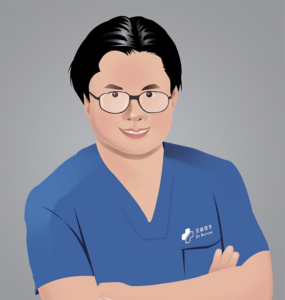
Hair transplant is not the same as Artificial or Synethetic Hair Transplant. Transplanting your own hair is the only permanent solutions to hair loss.
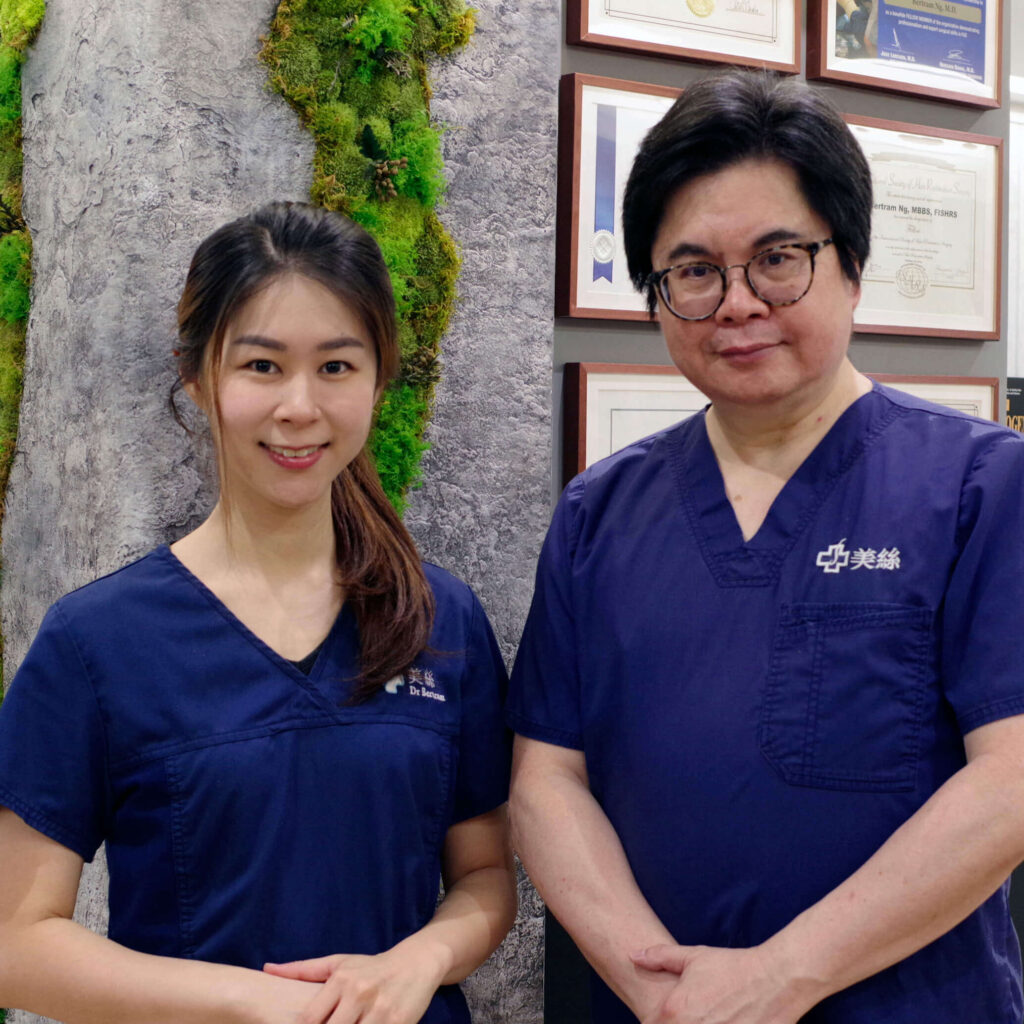
From consultation, surgery, to aftercare, you will receive continued personal care by our doctors, not just consultants.
Have a question? Please feel free to call our friendly customer service.
International Accreditations
Recognized by leading global medical bodies, our clinic stands as one of the most qualified and internationally accredited hair transplant centers in Hong Kong and mainland China. We are proud to uphold the highest standards in medical ethics, safety, and surgical expertise.
Hair transplant is the ultimate solution to restores hair, but not everyone is good candidate.
Our online assessment helps determine if these procedures suit you, saving you time and costs.